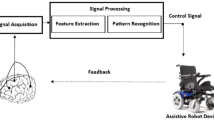Abstract
To construct and evaluate a novel wheelchair system that can be freely controlled via electroencephalogram signals in order to allow people paralyzed from the neck down to interact with society more freely. A brain–machine interface (BMI) wheelchair control system was constructed by effective signal processing methods, and subjects were trained by a feedback method to decrease the training time and improve accuracy. The implemented system was evaluated through experiments on controlling bars and avoiding obstacles using three subjects. Furthermore, the effectiveness of the feedback training method was evaluated by comparison with an imaginary movement experiment without any visual feedback for two additional subjects. In the bar-controlling experiment, two subjects achieved a 95.00% success rate, and the third had a 91.66% success rate. In the obstacle avoidance experiment, all three achieved success rate over 90% success rate, and required almost the same amount of time to reach as that when driving with a joystick. In the experiment on imaginary movement without visual feedback, the two additional subjects adapted to the experiment far slower than they did with visual feedback. In this study, the feedback training method allowed subjects to easily and rapidly gain accurate control over the implemented wheelchair system. These results show the importance of the feedback training method using neuroplasticity in BMI systems.











Similar content being viewed by others
References
Boser BE, Guyon I, Vapnik V (1992) A training algorithm for optimal margin classifiers. In: Proceedings of the Fifth Annual Workshop on Computational Learning Theory. ACM Press, pp 144–152
Carmena JM, Lebedev MA, Crist RE, O’Doherty JE, Santucci DM, Dimitrov DF, Patil PG, Heriques CS, Nicolelis MAL (2003) Learning to control a brain-machine interface for reaching and grasping by primates. PLoS Biol 1:664–670
Chapin JK, Moxon KA, Markowitz RS, Nicolelis MAL (1999) Real-time control of a robot arm using simultaneously recorded neurons in the motor cortex. Nature neurosci 2(7):664–670
Choi K, Hirose H, Iijima T, Koike Y (2005) Prediction of four degrees of freedom arm movement using EMG signal. 27th Annual internatoinal conferece of the IEEE engineering in medicine and biology society, (EMBC ’05),CD-Rom No. 1018
Choi K, Sato M, Koike Y (2006) Consideration of the Embodiment of a New, Human-centered Interface. IEICE Trans Inf Syst E89-D (6)
Choi K, Hirose H, Sakurai Y, Iijima T, Koike Y (2007) Prediction of arm trajectory from the neural activities of the primary motor cortex using a modular artificial neural network model. 14th International Conference on Neural Information Processing (ICONIP 2007)
Cichocki A, Amari S (2002) Adaptive blind signal and image processing, vol 1. Willey, New York
Cristianini N, Shawe-Taylor J (2000) An introduction to support vector machines. Cambridge University Press, Cambridge
Hochberg LR, Serruya MD, Friehs GM, Mukand JA, Saleh M, Caplan AH, Branner A, Chen D, Penn RD, Donoghue JP (2006) Neuronal ensemble control of prosthetic devices by a human with tetraplegia. Nature 442(13):164–171
Keerthi SS, Lin CJ (2003) Asymptotic behaviors of support vector machines with Gaussian kernel. Neural Comput 15(7):1667–1689
Koike Y, Kawato M (1995) Estimation of dynamic joint torques and trajectory formation from surface electromyography signals using a neural network model. Biol Cybern 73:291–300
Leuthardt EC, Schalk G, Wolpaw JR, Ojemann JG, Moran DW (2004) A brain-computer interface using eletrocorticographic signals in humans. J Neural Eng 1:63–71
Masa-aki Sato, Yoshioka T, Kajihara S, Toyama K, Goda N, Doya K, Kawato M (2004) Hierarchical Bayesian estimation for MEG inverse problem. NeuroImage 23:806–826
Middendorf M, McMillan GR, Galhoun GL, Jones KS (2000) Brain-computer interfaces based on the steady-state visual evoked response. IEEE Trans Neural Syst Rehabil Eng 8(2):211–214
Musallam S, Corneil BD, Greger B, Scherberger H, Andersen RA (2004) Cognitive control signals for neural prosthetics. Science 305(9):256–262
Ramoser H, Muller-Gerking J, Pfurtscheller G (2000) Optimal spatial filtering of single trial EEG during imagined hand movement. IEEE Trans Rehabil Eng 8(4):441–446
Serby H, Yom-Tov E, Inbar GF (2005) An improved P300-based brain-computer interface. IEEE Trans Rehabil Eng 13:89–98
Wang Y, Wang R, Gao X, Hong B, Gao S (2006) A practical VEP-based brain-computer interface. IEEE Trans Neural Syst Rehabil Eng 14(2):234–239
Wolpaw J, Birmbaumer N, McFarland D, Pfurtscheller G, Vaughan T (2002) Brain computer interfaces for communication and control. Clin Neurophysiol 113:767–791
Wolpaw JR, McFarland DJ (2004) Control of a two-dimensional movement signal by a noninvasive brain-computer interface in humans. PNAS 101:17849–17854
Acknowledgments
This research was partly supported by a contract with the National Institute of Information and Communications Technology project entitled, 'Multimodal integration for brain imaging measurements.'
Author information
Authors and Affiliations
Corresponding author
Additional information
Communicated by Dick F. Stegeman.
Rights and permissions
About this article
Cite this article
Choi, K. Control of a vehicle with EEG signals in real-time and system evaluation. Eur J Appl Physiol 112, 755–766 (2012). https://doi.org/10.1007/s00421-011-2029-6
Received:
Accepted:
Published:
Issue Date:
DOI: https://doi.org/10.1007/s00421-011-2029-6




